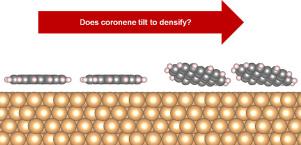当前位置:
X-MOL 学术
›
Surf. Sci.
›
论文详情
Our official English website, www.x-mol.net, welcomes your
feedback! (Note: you will need to create a separate account there.)
When do hydrocarbons dewet metal surfaces? The case of coronene on Cu(111)
Surface Science ( IF 2.1 ) Pub Date : 2020-10-01 , DOI: 10.1016/j.susc.2020.121603 Chen Santillan Wang , Konrad Thürmer , Scott Skeen , Norman C. Bartelt
Surface Science ( IF 2.1 ) Pub Date : 2020-10-01 , DOI: 10.1016/j.susc.2020.121603 Chen Santillan Wang , Konrad Thürmer , Scott Skeen , Norman C. Bartelt

|
Abstract We have used scanning tunneling microscopy and density functional theory calculations to study molecular layers of coronene on Cu(111). The structure and stability of these layers is determined by the balance between coronene-substrate and coronene-coronene interactions. Here, we characterize this balance by measuring the maximum coverage before coronene dewets the substrate to form three-dimensional islands. We find that coronene molecules lie parallel to the substrate at the maximum coverage, in contrast to previous observations of tilted coronene on metal surfaces. We attribute this previously reported tilt to a metastability caused by an activation barrier to nucleate three-dimensional islands.
中文翻译:

碳氢化合物何时使金属表面脱湿?Cu(111)上晕苯的情况
摘要 我们使用扫描隧道显微镜和密度泛函理论计算来研究 Cu(111) 上的晕苯分子层。这些层的结构和稳定性取决于晕苯-底物和晕苯-晕苯相互作用之间的平衡。在这里,我们通过测量晕苯对基材进行去湿以形成三维岛之前的最大覆盖率来表征这种平衡。我们发现晕苯分子在最大覆盖范围内平行于基底,这与之前在金属表面上倾斜的晕苯的观察结果形成对比。我们将之前报道的这种倾斜归因于由激活障碍引起的亚稳态,从而使三维岛成核。
更新日期:2020-10-01
中文翻译:

碳氢化合物何时使金属表面脱湿?Cu(111)上晕苯的情况
摘要 我们使用扫描隧道显微镜和密度泛函理论计算来研究 Cu(111) 上的晕苯分子层。这些层的结构和稳定性取决于晕苯-底物和晕苯-晕苯相互作用之间的平衡。在这里,我们通过测量晕苯对基材进行去湿以形成三维岛之前的最大覆盖率来表征这种平衡。我们发现晕苯分子在最大覆盖范围内平行于基底,这与之前在金属表面上倾斜的晕苯的观察结果形成对比。我们将之前报道的这种倾斜归因于由激活障碍引起的亚稳态,从而使三维岛成核。











































 京公网安备 11010802027423号
京公网安备 11010802027423号